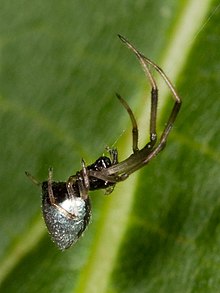
Back ارجيرودس ARZ Argyrodes CEB Diebsspinnen German Argyrodes Spanish Argyrodes French イソウロウグモ Japanese Argyrodes Dutch Argyrodes NB Naʼashjéʼii aniʼįįhígíí NV Argyrodes Romanian
| Dewdrop spiders Temporal range:
| |
|---|---|

| |
| Scientific classification | |
| Domain: | Eukaryota |
| Kingdom: | Animalia |
| Phylum: | Arthropoda |
| Subphylum: | Chelicerata |
| Class: | Arachnida |
| Order: | Araneae |
| Infraorder: | Araneomorphae |
| Family: | Theridiidae |
| Subfamily: | Argyrodinae |
| Genus: | Argyrodes Simon, 1864[1] |
| Type species | |
| A. argyrodes (Walckenaer, 1841)
| |
| Species | |
|
93, see text | |
| Synonyms[1] | |
The genus name is a combination of the Ancient Greek "argyros" (άργυρος), meaning "silver", and the suffix "-odes", meaning "like".[4]
Argyrodes, also called dewdrop spiders, is a genus of comb-footed spiders that was first described by Eugène Louis Simon in 1864.[4] They occur worldwide, and are best known for their kleptoparasitism. They can spin their own webs, but tend to invade and reside in their hosts' webs.[5] This relationship can be commensal or even mutual if the dewdrop spider feeds on small trapped insects that are not eaten by the host.[6] Some species can even prey upon the host.[5]
- ^ a b Cite error: The named reference
NMBEwas invoked but never defined (see the help page). - ^ a b Levi, H. W.; Levi, L. R. (1962). "The genera of the spider family Theridiidae". Bulletin of the Museum of Comparative Zoology. 127: 16.
- ^ Levi, H. W. (1972). "Taxonomic-nomenclatural notes on misplaced theridiid spiders (Araneae: Theridiidae), with observations on Anelosimus". Transactions of the American Microscopical Society. 91: 534.
- ^ a b Simon, E (1864). Histoire naturelle des araignées (aranéides). Paris: Roret. doi:10.5962/bhl.title.47654.
- ^ a b Guarisco 1999
- ^ Tso 2000